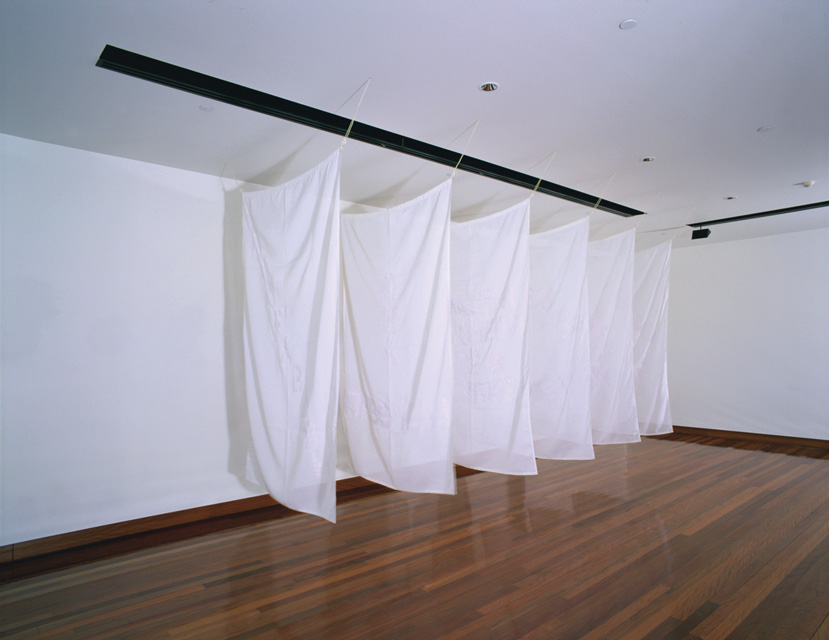


'Congratulations! It's a girl! Mother and daughter are both well! First tooth! She walked for the first time! She said "Papa" for the first time!' Rose Nolan's White trash banners (1996) relate a simple Elwood neighbourhood story—a Russian family's announcement of their daughter's birth and babyhood milestones with signs in their corner shop window.
The work comprises large, white fabric banners suspended from the ceiling, with the text in light grey material that has been stitched onto the banners. It is a celebration announced to the Elwood locals then taken up by the artist, who also lived in the area. Rose Nolan has transcribed the announcements in their original Cyrillic script, her reprocessing incorporates them to the historical consciousness of post-modernism.
Nolan's use of the banner is based on Russian political banners of the early twentieth-century. She takes the transcendent qualities of Russian Suprematism and marries them with the pragmatic materiality of Russian Constructivism. These two versions of Russian modernism emerged in an era when art had a far more revolutionary and heroic political function in society than it does today. By comparison, contemporary Australian art is compromised in the sense that its ability to actually 'make a difference' is generally thought to be non-existent. Utopian modernism sought to intervene directly into society, whereas recent Australian art, while not politically neutral, often focused on its own history and discourses.
Consequently, Nolan's use of early modern Russian styles and her large-scale installations gives her work a utopian quality and boldness which is at the same time undermined by her use of very low-tech materials and frequently (though not in this case) sad-sack themes and texts.
This is the result of Nolan's aspirations to an art that has faith in itself within an era in which art is fundamentally sceptical. The revolutionary tone implied in the reference to political banners is purely wishful thinking. The work's integrity is further compromised by its title, White trash banners. But within the context of Nolan's own era, the White trash banners are a rebellious work. Nolan's formative creative years were the 1980s, when monochromes were painted as the death of objective art. So this work might easily pass for an austere, nihilistic work that is participating wholeheartedly in the endgame of the monochrome as the end of painting. The whole monochrome debate did have an air of heroic posturing about it, being so absolutist and nihilistic. This work plays the game on the surface but actually undermines that whole macho position. It suggests instead that it is possible for art to have utopian values and suggests hope for the future might be more readily found in the joys of daily life.
However, dreaming of that possibility is as far as this work can go. Ultimately, the Elwood Russians beat Nolan to the punch in creating a community-based public art with utopian values. Nolan could only point out the loss of those values in contemporary Australian art.
- Lara Travis
Rose Nolan is represented in Australia by Anna Schwartz Gallery, Melbourne and Sydney.